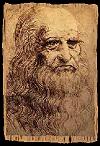|
Andrea di Michele di Francesco di Cioni (known as Verrocchio) was born in 1435, and trained as a goldsmith, becoming one of the most influential artists of his time. His workshop became a training ground for many important painters including Leonardo da Vinci.
Knowledge of some parts of Verrocchio's work is scanty though his early career was almost entirely taken up with metalwork. After this he went on to become a sculptor using the mediums of terracotta, stone and bronze. His subsequent career in sculpting can be tracked with some accuracy, but records of his efforts as a painter are few. We know that in 1472 his name was listed as a member of the Confraternity of St. Luke which was largely made up of painters. However, with the exception of the Baptism of Christ, no painting or altarpiece can be definitely attributed to him. Even with this work no documentary evidence has ever shown up. Verrocchio was also responsible for the painting of banners for jousting contests, and some theatrical masks; these all having since disappeared. Even with the Baptism of Christ it is thought that Verrocchio's main contribution was to develop the overall composition and design. Much of the actual painting work was left up to his more talented assistants with it being generally agreed Leonardo was responsible for the angel on the left and part of the background area; Botticelli and Credi also participated in this work, probably concentrating on the other angel. The one area of the painting probably by Verrocchio himself is the image of John the Baptist; it is thought that this figure was painted entirely without assistance as it displays Verrocchio's fascination with bones, tendons, muscles and other aspects of the human body. Another painting, which was started during the time Leonardo was with Verrocchio, is the altarpiece of the Madonna di Piazza done for the Cathedral of Pistoia. There have been continued efforts to associate Leonardo with this work and this is documented under the Paintings area of this Web site. In sculpture, Verrocchio's best-known works are as follows:
Verrocchio died in Venice at the age of 53. |
|

